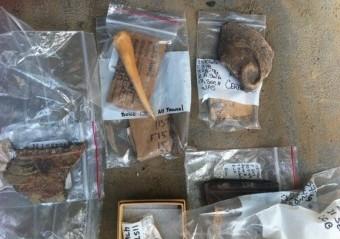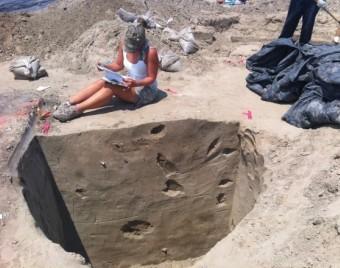PART. 2
Future of an ancient civilization
With easier access to parts of East St. Louis, lots adjacent to the new highway are likely to be bought and developed, Galloy said. Land owners who build without federal funds or permits are not required to hire an archaeologist before breaking ground, unless human remains are found on the site. "A lot of East St. Louis, I think, is prime for redevelopment because there's infrastructure there, but a lot of buildings are now gone, so people can redevelop it fairly easily," Galloy said. "If they do so and don't need any federal funds or permits, those areas will essentially be lost in terms of us being able to actually go out and do anything there."

Molly Duffy | Beacon intern
- The dig has unearthed about 5,000 items ranging from buildings to such household items as pottery fragments and bone tools.
The Archaeological Conservancy purchased two city lots and a surrounding acre in East St. Louis according to its website, but that area is the only piece of East St. Louis protected from redevelopment. The Illinois Archaeological Survey, of which Galloy is a member, has been evaluating how to possibly acquire protection for the site for the last few years. There has been talk of state or federal protection for the site, but the process is lengthy and wouldn't be finished before highway-adjacent lots would likely be sold. Galloy said that route would probably involve a new national park, one including Cahokia Mounds, the East St. Louis site and others. That doesn't seem likely though, since Illinois hasn't shown any interest in giving up Cahokia Mounds to the park service. "Whether it be a national park or a national monument, it doesn’t look like that’s going to happen, at this time anyway," Iseminger said. "I know our agency is not interested in giving up the site to be a part of the National Park Service."
Development and destruction
Regardless of the site's possible future protection, Galloy said it might be too late to save parts of the site. "Unfortunately, we may not have enough time to put things in place before the site starts to fall to development," he said.

Molly Duffy | Beacon intern - Several deep pits have been revealed.
Galloy said the sites could dodge destruction with cooperation between landowners and archaeologists. The fill left over from the 1800s presents an opportunity to build above the remains of Cahokia. "Unless you're digging a really deep hole, you're not disturbing any archaeological sites," he said. The IAS has been looking to raise funds for a feasibility study that would show what preservation in East St. Louis would actually look like. The study would be done by an outside group. Galloy said purchasing parts of the site would be difficult because of costs and the multitude of land owners. "It's kind of tricky figuring out how to go forward," he said. "It's not at all obvious to us." With community support, gaining protection becomes easier, he said, but in an area begging for economic development, that could be difficult to acquire. "Because of the economic problems in the East St. Louis area, it's going to be a hard sell to try to convince people that we should just set aside a big piece of property, (and) not develop it," he said. "Redevelopment could provide jobs for people and increase the tax base for the city."
When Cahokia Mounds became a state park, the effort began with a group of archaeologists, but was also backed by the community. Galloy said that isn't the typical scenario, though. "Unfortunately, there's a long history in this region of sites being lost and the local populace not really seeming to know or to care," he said. The East St. Louis site is just as significant as Cahokia Mounds, Galloy said. The only difference is the level of protection. When the East St. Louis mounds were destroyed, few people noticed, he said. "The mounds were destroyed well over 100 years ago and we think, 'How could people let that happen?'" he said. "We're kind of in the same position today. Unless archaeologists and local people of get together and try and fight for some sort of protection, it's not going to happen."